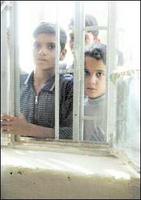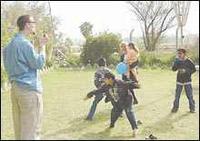Ciao, Bella
 The man looked to be in his 70s.
The man looked to be in his 70s.Normally, this time of year, he would be taking care of the lawn in preparation of spring.
Instead, he spent most of his afternoon
swatting at the falling snow with a small
whisk broom.
'Scusa,' I said finally, trying to squeeze by him and onto the narrow walkway between us.
'Prego,' he gestured with a friendly wave of
the hand.
In Italy, 57 million people drive 30 million cars through streets lined with 2,700 years of cultural history, yet there exists not one single shovel.
Instead, the natives dealt with the freakish snowstorm much as they do with any crisis.
They pulled brooms out of closets. They attached 'chains' - little more than red and yellow paper clips hooked together - onto the tires of their cars. And the children used scraps of
cardboard, flying discs and their own backsides as makeshift snowboards to go giddily gliding down winter-slick hills.
This is a culture of people who know how to live their whole lives every single day.
I began my winter vacation 37,000 feet above the earth, rushing more than 600 miles
per hour from the edge of lower Manhattan and nose forward heading to Rome.
The ancient city revealed itself in a rich architectural tapestry of temples and domes, cathedrals, bell towers and ancient structures wounded - but not obliterated - by time.
Surrounded by walls, it is a civilization mostly unspoiled by modernization, despite the
occasional McDonald's restaurant boasting Doppio Cheeseburger and Patatine Grande specials.
Giant flashlights strung across a clothesline act as street lamps along the Via Nazionale,
where smart cars zip across cobblestone streets in a challenging game of James Dean-like 'chicken.' Inevitably, someone yields the right of way - always at the last moment.
From the traffic lights to sticker prices, natives will tell you that the rules of the country are best used as guidelines than mandatory bylaws. 'It's only a suggestion,' they say.
In the early morning hours at the Campo de Fiore, shoppers line up at a multitude of pale, sun-muted tents in search of that day's fresh fruit, meats and vegetables that will be
prepared for that evening's meal.
Their faces wear the emotional intensity mixed with irony captured by Rossellini, DeSica
and Fellini - the country's great filmmakers of the 20th century, and poke among the fresh fruit oblivious to the dark, brooding figure of Giordano Bruno, a statue erected in the center of
the square where he was burned at the stake in the early 1600s.
Some congregate outside the cafés for a smoke and argue about country's new indoor
smoking ban. Recently hung signs on cafes read 'Vietato Fumare.'
Everyone is concerned with the health of the Pope, who they like, although the Vatican itself, many will offer, is commonly thought of as being more interested in the business of making money than it is in the work of helping the people.
Guidebooks list the names of the popular places, from The Forum and the Colosseum to the Fontana di Trevi. What they cannot accurately translate, however, are the feelings of awe
that comes with standing inside of the Pantheon - a remarkably intact structure built in
125 A.D. - or the stunning contrast of standing on the 96th step of the historic
Piazza di Spagne and overlooking the elegant string of shops whose signs boast: Prada,
Christian Dior and Yves Saint Laurent.
Leaving Rome, heading north and cruising along the Autostrada, there are joys to be found everywhere.
There are pleasant discoveries inside of a nondescript building in Umbria, where a man painstakingly uses a brush-stroke to hand-detail an original design on cups, plates and pottery.
In another room, shelf after shelf is lined with local flavors, from truffles to wines to bottles
of olive oil - whose icy-glaze show the effects of the cold press.
In Assisi, a towering city hovers on the mountaintop in an ode to St. Francis;
Pisa boasts its famous crooked tower and, in Siena, the sky is poked with the
black-and-white marble of its Gothic cathedrals.
Most stunning of all is the city of Florence - Firenze to the local ear - which lies in the region
of Tuscany - land of language and of art, piazzas, domed cathedrals and the winding
River Arno.
It has been home to Giotto and Dante, Brunelleschi, Ghiberti and Michelangelo -
whose sculpture of 'David' just celebrated its 500th birthday. It is housed in the Galleria
del Accademia, a gallery outdone only by the Uffizi Gallery nearby.
Among the sprawling 13th century villas and hidden palaces of Tuscany a few kilometers
away, an old man with a whisk broom continues with the task of swatting away the snow.
A few meters away, stone balconies and massive arches rise from piazzas, lined beneath
with fruit stores, 'tabacchi' shops and cozy storefronts specializing in everything from
chocolates to gelato to risqué women's underwear.
Cafés are everywhere and, opposite of the American way of life, this is the only place
where Italians will make haste. A quick shot of espresso and then it is on to the day of work
and nights of multiple-course meals and beautiful wine - each of them moments to be
savored.
In the setting sun, the church bells ring on the hour from the bell towers in the main square. The sky fills with a million birds that scatter in flight, as if they were startled by the mighty clang of the bells, before finally settling atop the snowy branches of the cypress trees to
collect their wits.
The old man with the broom, meanwhile, is done for the day. He pulls on the massive, fortress-like doors at the rear of the villa and opens a panorama of clay-orange roofs
and old church towers.
The snow-topped mountains are illuminated by the setting sun and topped by a smoldering blue-red skyline of billowing clouds that are every bit as deep, exotic and seductive
as this land of itself.
'Buono Sera,' the old man says, which in this land does not mean 'Good night - the day is over,' but 'Good Evening,' - as in the night has only just begun.
by Thomas Dimopoulos
published in The Saratogian, March, 2005.





